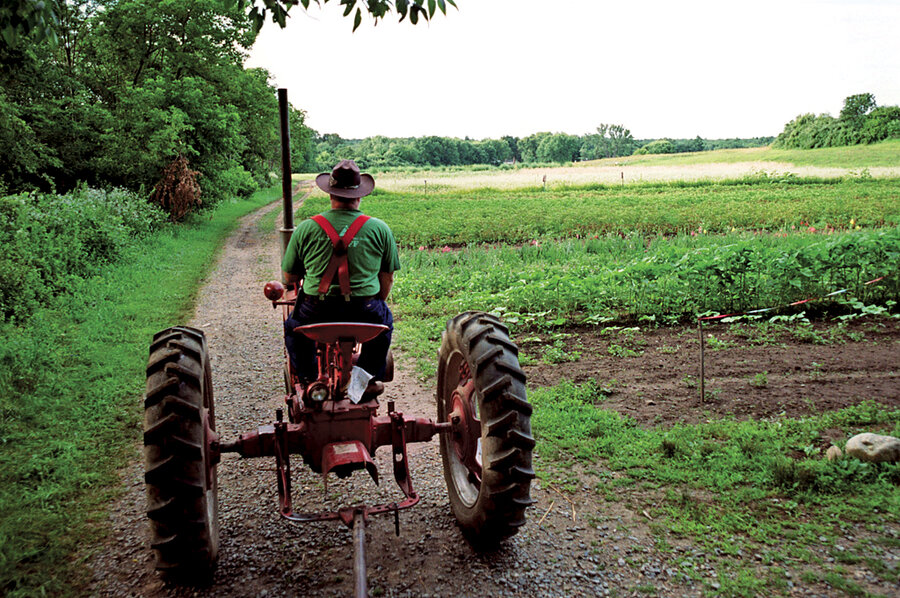Home, restored
Loading...
Dairy farming makes for a homebound life, and though Charlie and I have traveled over the years, it has generally been in turns. I'd drive or fly east for a visit with family while he did the twice-a-day milking. He'd buy a train ticket for a two-week exploration of distant states, and I'd fill the tank each day.
As I strapped the Surge buckets under our Holstein, Brown Swiss, and Guernsey benefactors, I'd hope that nothing major broke down on my mechanically inept watch. I was good with the cows and draft horses, but not to be counted on for maintaining the nuts and bolts of the business – the vacuum pump motor and pressure gauge, the all-important metal pulsators, not to mention the plumbing, wiring, gates, and pasture fencing. We joked that the farm, left solely in my care for long, would become a distant memory for a postproduction herd of widely roaming cows.
When I'd return home from my trips I'd almost always see improvements here and there – a newly hung gate, an electric outlet over the feed bin, a door that no longer stuck.
Charlie, back from his breaks, would cast a critical eye at, say, a repair to a stall partition done with baling twine, or a sawhorse barricade fronting a listing fence, and roll up his sleeves. For the most part, though, we both stayed put, enjoying the daily rhythms of a lifestyle we'd each chosen as our second careers, carrying on through the 1980s and '90s and into the 21st century.
Today, with the land, barns, and house leased to a young friend with a new herd-share business, Charlie and I are free to spend long stretches of time in the small home we restored in Indiana. But as part of Jason's lease contract, we reserved the right to return now and then to the farm's cabin – a one-room living space with a nearby timber-frame library, barn, and workshop – set amid a grove of sugar maples at the edge of the back pasture a half mile from the house and road. At the heart of things is the outdoor hearth we use each spring to boil the sap we collect to syrup. The quasi-pioneer village has long been our special retreat.
The changes we see upon our visits to the farm have for the most part highlighted the new energy enveloping the place – a field freshly plowed and planted, a new calf shadowing its mother in the front pasture, a fresh coat of paint on the farmhouse. Fortunately our cabin, lacking plumbing and electricity, takes only sporadic maintenance and minimal upkeep. A couple of years ago Charlie repaired the roof and interior beams of the library, damaged by one massive limb of a storm-felled maple. We'd eyed the tree's neighbor, with a partially hollowed-out trunk.
We knew we should have it cut before it, too, fell. But we put off that pricey step. This week, returning home ahead of Charlie after a month in Indiana, I lost no time walking back to the sugar grove to check on things. Crossing the stream I took stock of its newly scoured bottom, compliments of the previous week's gully-washer. Climbing the hill, the first thing I saw was that the tree had toppled, and mightily, its big limbs twisted and strewn over a considerable area. With a jolt of relief I realized that while it might have taken out the library completely, it had listed the other way. Its bulk completely blocked the path between buildings and crushed only some bordering brush and a half- decayed picnic table that needed to be chopped for kindling anyway.
One branch had nudged the seat of Charlie's horse-drawn forecart as if making a subtle adjustment to the vehicle before he hitched the team again. No specialist could have planned a less damaging demise: It was as if the tree, which had given sap so plentifully over the years, had made a concerted effort to find the one lay that would avoid catastrophic damage to our little complex.
When Charlie arrives we'll roll up our sleeves and put up enough firewood for a full winter's worth of visits – and fuel for next spring's sap boiling.
Given our long absences, we no longer move to the farm's daily rhythms, orchestrate or even witness its subtle transformations – or hear every tree that falls. Still, it welcomes and confronts us with its gifts and challenges every time we do show up. As we slip under its spell again for a week or two, it's almost as if we had never left at all.







